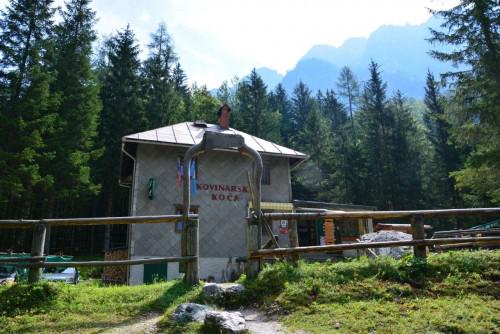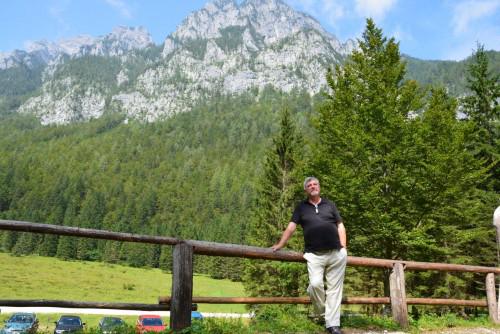



The surroundings around Slovenia's highest mountain, Triglav, have become a popular destination not only for Slovenians, but also for foreigners. However the highest peak isn't the only feature that has been drawing people to the region for centuries. At the foot of the mighty mountain are three valleys, each valley a separate story for itself - Kot, Krma and Vrata. Each of these valleys has its own target group of mountain lovers. That is why it comes as no surprise that since far back in time the valleys have been full of resting stations, and later also mountain huts, which represent important Slovenian historical monuments, rare elsewhere in the world.
Each alpine hut is different from the other. Sometimes because of its location, sometimes because of the way it looks, but most often because of the people that take care of them. Among the three valleys that lie below our highest mountain, this time we chose Krma. The valley is foremost the starting point for winter ascents on Mount Triglav. A nicely marked trail leads through the valley, which proves to be the right choice on hot summer days due to its shady paths and nice views. Approximately one third up the valley the Zasip alpine pasture opens up under the mighty Debela Peč peak with its vertical walls. On the left lies the Kovinarska koča mountian hut.
The people that work as mountain hut keepers are often the reason why people don't feel as if they're visiting a mountain hut. They feel as if they're actually visiting the keepers of the hut. That is how some mountain huts in the past got their unofficial names – after the kind people that gave the huts a soul. The first thing you'll notice in the Kovinarska koča hut is an elderly couple which just can't sit still. Those are Brigita and Franci Rozman.
"We've been working here with my wife for five seasons now. I come from the lowland parts of Slovenia, from Prlekija, from a wine region. A long time ago I met my wife and love made me stay here in Gorenjska, which is a region quite different from back home," is how Franci tells his story.
Of course Franci point out that the history of the Kovinarska koča mountain hut doesn't begin five years ago. The first resting stop on the mountain was built by the PD Javornik -Koroška Bela mountain club from the remains of an old shepherd's cottage. It was opened on the 26th of December, 1948. In the spring of 1959 they started building a new, bigger resting station, which was officially opened a few months later, on the 19th of July 1959 – on the 90th anniversary of the Železarne Jesenice ironworks company. The hut was named after Jesenice's ironworkers, members of the mountain club, which put in 4660 hours of work to build the hut in record time. In 1963 they installed the plumbing system and built the veranda.
The mountain hut was then renovated several times and additionally equipped. It was again fully renovated in 1983, when the hut hosted Slovenia's central event marking Mountaineers' Day. In 1994 solar cells were installed on the roof. In 2008 the hut was connected to the public electricity and water networks. Brigita's and Franci's story begins a year later.
"We're both retired. My wife always had the wish to be a mountain hut keeper. But she always had in mind a smaller hut, something not too demanding and easier to take care of, she thought. Now we see that's certainly not the case. She was then asked by the PD Javornik - Koroška Bela mountain club if she could jump in for one season, as they had no one to take care of the hut. Well, it's our fifth season now. And we're not sorry we're here. There is a lot of work. There is no schedule. From dawn till dusk as they used to say. But it's not all about being paid for what you do because it's not all about money. It's more about enjoying working with people," says Franci and adds that what they do, they do with pleasure.
The Krma Valley is a closed valley, but despite that the Zasip alpine pasture offers a nice view of the surrounding peaks. On the east of the valley above the forest behind the hut rise the steep peaks of Stresenica, Klečica and Debela peč; towards the southeast and south the mountain range continue on to the northern walls of the Lipanski and Debeli vrh peaks, the Mali and Veliki Draški vrh peaks, the Tosc and Vernar peaks; on the west of the valley we can see the steep slopes of the Rjavina, Luknja peča, Dimniki in Macesnovec peaks; on the north the Krma Valley spreads towards the Radovna Valley, above which rise the forested slopes of the lower peaks. All the more the reason for the hut to serve as a point of information.
Delicious smells from the hut
The food we get at alpine resting stations and huts is a chapter for itself. It takes a lot of time and will for Brigita in Franci to prepare it – normal things like gas stoves, electricity and water are more of an exception than a rule up in the mountains. Even when you have all that, everything else still has to be brought up to the mountain hut. And then only a few pairs of hands take care for the many hikers that often come to Krma especially for the genuine homemade food.
The years of the building of the first huts in Slovenia's mountains are of historic importance for the country. At that time Germany's Alpinverein alpine clubs also tried to dominate Slovenia's mountains. In some places there were already German marked trails, German climbing routes and even German huts where foreigners were treated first.
Those days are now long gone, but the huts still remain. Those that take care of them do it because of their love for mountains and tradition. That's why our mountains are even more beautiful, and even more pleasant, for all those searching and eventually finding different things. And although without the keepers there would be no mountain huts, these people remain modest.
Those that visit mountain huts understand their meanings in different ways. The same goes from Brigita's and Franci's guests, enjoying the pleasant moments of a nice summer day in front of the Kovinarska koča mountain hut and talking to the keepers. Up there everyone finds what he needs – whether it is food, a nice view, or simply peace.
You can listen to the interview with Franci Rozman by clicking on the link below:
Jure Čokl, 1. program; translated by K. J.


































































